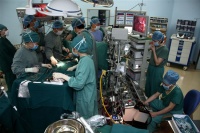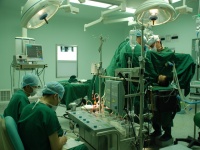体外循环
来自医学百科
112.247.109.102(讨论)2014年1月26日 (日) 08:58的版本 (以“<b />{{百科小图片|bk7eq.jpg|}} <b>体外循环</b>:体外循环是指应用人工管道将人体大血管与人工心肺机连接,从静脉系...”为内容创建页面)
体外循环:体外循环是指应用人工管道将人体大血管与人工心肺机连接,从静脉系统引出静脉血,并在体外氧合,再经血泵将氧合血输回动脉系统的全过程,又称心肺转流,主要应用于心脏、大血管手术。
Extracorporeal circulation: The technique of mechanically circulating the blood so the heart doesn't have to. The device used for ECC is called the heart-lung machine or the cardiopulmonary bypass circuit. This device drains the blue blood from the patient, places
oxygen in the blood, and returns (or pumps) the red blood back into the aorta for distribution to the whole body. To prevent clotting in the heart-lung circuit, strong anticoagulation with heparin is needed.

